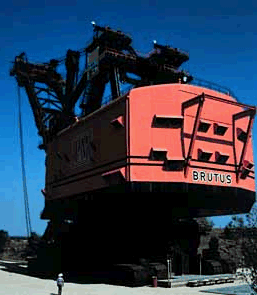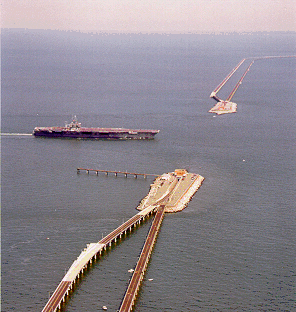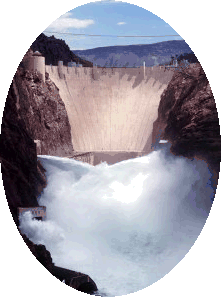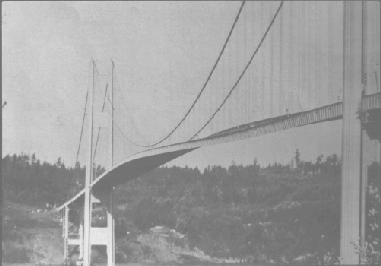
FUN FACTS
Bakelite
Bakelite was the first plastic not to
melt when put in high temperatures.
In 1907, the American chemist, Dr. Leo Baekeland made a breakthrough
when he accidentally created the first commercially successful thermosetting
synthetic resin, which was called Bakelite (known today as phenolic resin).
He realized that a resin which would not melt under high temperatures would
have a much wider appeal when used as a molding compound. Use of Bakelite
quickly grew. It has been used to make products such as jewelry, telephones,
and pot handles.
Big Brutus

Big Brutus is the second largest electric
shovel in the world.
In May 1963, Big Brutus came alive. After taking more than 150 railroad
cars and over a year to build, Big Brutus was in operation. Engineers designed
the 15,000 horsepower shovel to revitalize the strip-mining industry. It is
16 stories (160 feet) tall and has a boom 150 feet long. At 11 million pounds,
Big Brutus' bucket can lift up to 150 tons of coal - enough to fill three
railroad cars. It ran 24 hours a day at a maximum speed of 0.22 mile per hour.
It used as much electricity in one day as town of 15,000 people. In 1974,
Big Brutus had to be shut down because its cost of operation was twice that
of the value of coal it recovered.
Cellular
Phone
The first cellular phone weighed 2
pounds!
Martin Cooper is considered the father of the handheld cellular phone
which was invented in 1973. It weighed a whopping 2 pounds! Initially, cell
phones were used only for military and company business purposes. They were
popular "gadgets" on TV and in film for many years. Cell phones
became available for general use in 1983. According to a study conducted by
Teenage Research Unlimited in 2000, about 24 percent of American girls own
a wireless phone. Cellular phones are even more popular in Europe than in
the United States; nearly 2/3 of all Europeans have a wireless phone.
Chesapeake
Bay Bridge-Tunnel


The Chesapeake Bay Bridge-Tunnel is
considered to be "One of Seven Engineering Wonders of the Modern
World."
The Chesapeake Bay Bridge-Tunnel opened as a two-lane highway in 1964. Thirty-five
years later, the southbound side opened, making it a four-lane highway. The
20-mile road cuts 95 miles from the trip between Virginia Beach, Virginia
and WIlmington, Delaware. It is made of two high bridges, two, one-mile tunnels,
four man-made islands, and 12 miles of trestle. Each island is 10 acres in
size and has almost 1.2 million tons of rock armour. The 12 miles of trestle
are supported by more than 5000 concrete piles.
Hoover Dam


The Hoover
Dam weighs more than 6.5 million tons.
The Hoover Dam is one of the tallest concrete dams ever built and
it created one of the largest manmade lakes in the United States. At 726.4
feet tall, it took 200 engineers from several consulting firms and the Bureau
of Reclamation to design the dam. It has 3,125,000 cubic yards of concrete
and weighs more than 6.6 million tons! Construction of the dam, power plant,
and related works too five years to build and was finished two years ahead
of schedule. The reservoir created can hold enough water to cover the entire
state of Pennsylvania with water one foot deep.
Royal Gorge
Bridge
The Royal Gorge Bridge is the world's
highest suspension bridge.
At 1,053 feet above the Arkansas
River, the Royal Gorge Bridge was completed in only six months with no fatalities.
In 1907, the federal government deeded Royal Gorge to the town of Canon City,
Colorado for use as a municipal park. To enhance the appeal as a tourist attraction,
a bridge was needed to cross the gorge. So, in 1929, Lon Piper undertook the
construction of a one-lane toll bridge. Piper designed a bridge 1,260 feet
long and 18 feet wide. The bridge is suspended from two 200-ton cables. Each
cable has 2,100 strands of No. 9 galvanized wire in it. The floor of the bridge
contains 1,000 tons of steel and almost 1,300 wooden planks. It took only
$350,000 to build the Royal Gorge Bridge. To replace it today, it would cost
over $10 million.
Tacoma Narrows
Bridge

Engineers learned a great deal when
wind collapsed the Tacoma Narrows Bridge.
After the Federal Government refused to pay $11 million to build a
bridge that crossed the Tacoma Narrows (cutting at least 40 miles off the
trip between Tacoma and Bremerton, WA), the state turned to engineer Leon
Moisseiff. Moisseiff calculated that he could design a thin-plate girder-type
bridge for only $6.4 million.
On July 1, 1940, after two years of construction, the first Tacoma Narrows
Bridge was opened to the public. As soon as the bridge opened, it was noticed
that it would twist and turn in even the smallest wind. People gave it the
nickname, "Galloping Girtie." Just four months and one week after
opening, on November 7, 1940, the bridge collapsed during a 42-mph windstorm.
